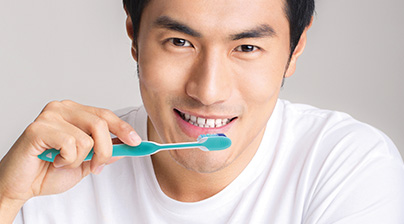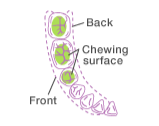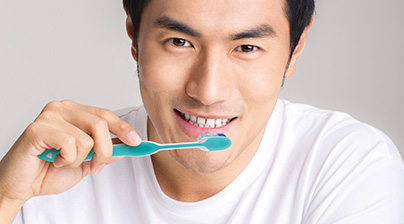Basics of Tooth Brushing

The major cause of caries and periodontal disease is plaque. Keep your mouth clean and brush your teeth after meals and before bedtime, so as to prevent periodontal disease.
POINTS TO NOTE
- Remove plaque carefully using a brushing method that suits your teeth or teeth alignment.
- Bacteria increases particularly during sleep; clean your mouth before bedtime.
Purpose of Tooth Brushing and Reminders.
To remove plaque, it is important to brush your teeth thoroughly. If plaque is always left remaining on the same spot, that spot will become susceptible to caries or periodontal disease.
Removal of Plaque
Plaque is a mass of live bacteria, and the major cause of caries and periodontal disease. Removing this plaque is the main purpose of brushing teeth.
Establish the Habit of Brushing Your Teeth after Meals and before Bedtime
Our mouths become susceptible to caries 20 minutes after eating. It is important to establish a habit of brushing our teeth after eating. In addition, the self-cleaning effect of saliva becomes lower due to a decrease in saliva production during sleep, which creates an environment in which bacteria easily grows. For this reason, it is important to brush our teeth carefully, and particularly before bedtime. It has become clear that, if tooth brushing before bedtime is insufficient, bacteria will grow during sleep and will be 30 times greater at the time of awakening than it is after dinner.
“Can plaque be removed just by rinsing the mouth?”
Just rinsing the mouth with water cannot remove plaque. Plaque is made of a sticky substance called dextran and bacteria. Plaque also is non water-soluble, and strongly adheres to the surface of teeth like glue.
In order to remove plaque, brushing your teeth is necessary. To remove plaque between teeth where toothbrush bristles are hard to reach, you need to use dental floss or an interdental brush.
Tooth Brushing Basics and Points to note
You should use a brushing method that suits the shape of your teeth or your teeth alignment. If you brush your teeth improperly, such as by brushing too strongly, the bristles will become splayed and you will not be able to brush your teeth efficiently. You will also damage your gums or tooth roots.
Removal of Plaque
- Properly place the tips of the bristles on the surface of the teeth
(between the teeth, areas between the teeth and gums). - Brush with a low amount of force
(150 to 200g of pressure; a level at which the bristles do not become splayed). - Move the brush back and forth in small motions
(brush 1 or 2 teeth at a time, with a movement range of about 5 to 10 mm)

Points to Note for Brushing Teeth According to the Type of Teeth or Teeth Alignment

Misaligned teeth
- Vertically place the toothbrush against each misaligned tooth, and move the tips of the bristles up and down in small motions. To brush a short tooth, insert the toothbrush at an angle from the side and move the brush in small motions.

Short teeth
- Insert the toothbrush at an angle from the side and move the brush in small motions.

Areas between the teeth and gums
(a brushing method effective for the prevention and improvement of
periodontal disease)
- Place the toothbrush at a 45° angle against the area between your teeth and gums and move the toothbrush back and forth in small motions.
- Areas where plaque easily accumulates

Points to Note for Brushing Teeth

- Brush the back of the teeth, front of the teeth and the
chewing surface separately - Brush each tooth carefully in order, so that you won’t
miss any areas.





